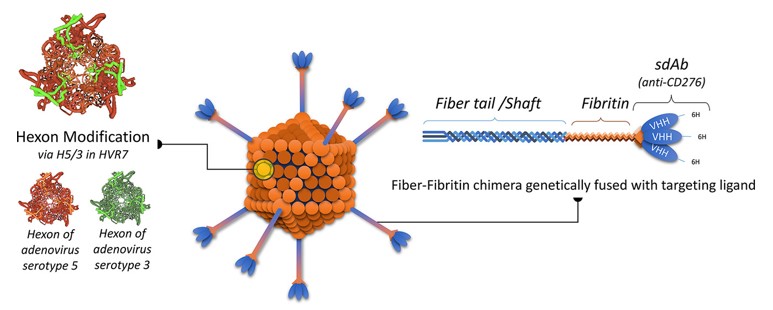Genetic Incorporation-based Viral Vector Development Platform
Genetic ligands genetic incorporation can achieve the desired targeting specificity of viral vectors. Our company has extensive expertise in vector engineering, particularly in genetic incorporation-based viral vector development. Whether you need a specific technology or have a specific target, our top team will work closely with you to develop custom solutions and provide efficient methods to accelerate your development of rare disease therapy.
Targeting Viral Vectors by Genetic Incorporation
To avoid the potential complexity of adaptor-based viral vector systems, researchers have developed genetic modifications to viral vectors involving the genetic incorporation of targeting ligands. By fusing the targeted ligand into the envelope protein or capsid of the viral vector to generate a single virion molecule that recognizes the target cell. While this strategy is technically challenging compared to adaptor-based approaches, this single-component system allows for the production of homogenous retargeted viral vector particles. In addition to this, this strategy eliminates the need to design and develop separate adaptor molecules, facilitating the high-titer production of viral vectors in gene therapy of rare diseases.

Fig.1 Schema to accomplish in vivo targeting via the CD276 axis exploiting camelid sdAb incorporated into the adenoviral vector capsid. (Lee, Myungeun, et al., 2021)
Our Services
Over the years, our company has been committed to providing customers with genetic incorporation of targeting ligands to achieve the desired targeting specificity of viral vectors and providing our customers with genetically modified vectors with broadened tropism, specific targeting, or ablated native tropism for rare disease therapy research and development. Optional services include but are not limited to:



Single-chain antibody Genetic incorporation
Develop single-chain antibody Genetic incorporation services to meet the targeting strategies of multiple vectors, including adenovirus, AAV, retrovirus, herpes simplex virus, and measles virus.
Complex Polypeptide Ligands Genetic incorporation
Provide genetic incorporation of complex polypeptide ligands such as cytokines and growth factors to produce highly specific viral vectors.
Small-peptide Motifs Genetic incorporation
Use RGD motif-containing small peptides targeting integrin vectors or poly-lysine (pK7) peptides targeting heparan sulphate vectors to improve the efficiency of vector delivery.
In addition, our company helps customers generate highly diverse viral libraries by displaying random peptides at specified locations, random insertional mutagenesis, random point mutagenesis, and in vitro recombination and selecting vectors with new tropisms from viral libraries through a selection strategy that focuses on specific cell types.
Why Choose Us?

- One-stop platform with an experienced technical team
- Careful design and transparent operation process
- Cutting-edge technology and equipment
- Ability to customize products and services
- Global reach and distribution network
- Unmatched project management capability
Project Workflow

Equipped with a dedicated research team and advanced technology, our company is committed to providing customers with genetic incorporation-based viral vector development to produce viral vectors with the desired target specificity. Our scientists specializing in viral vector development will work with you to develop the most appropriate strategy and provide you with the most meaningful data for the development of gene therapies for rare diseases. If you are interested in our services, please feel free to contact us for more details and quotation information of related services.
Reference
- Lee, Myungeun, et al. "Advanced genetic engineering to achieve in vivo targeting of adenovirus utilizing camelid single domain antibody." Journal of Controlled Release 334 (2021): 106-113.
All of our services and products are intended for preclinical research use only and cannot be used to diagnose, treat or manage patients.
